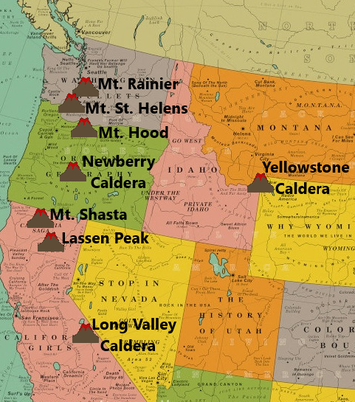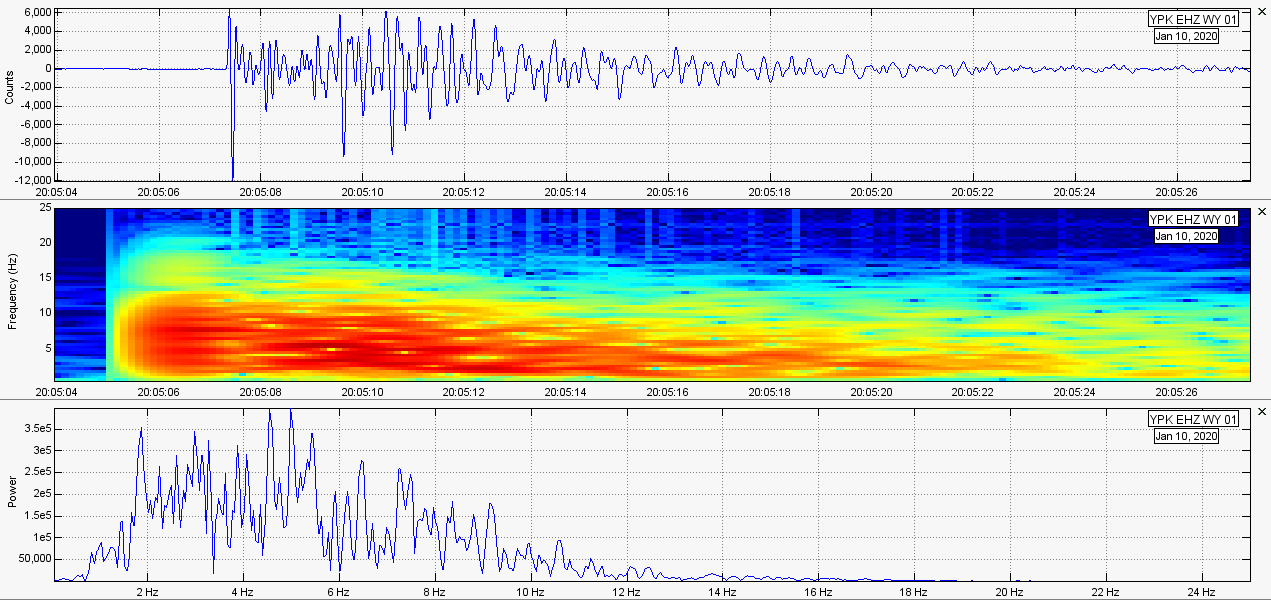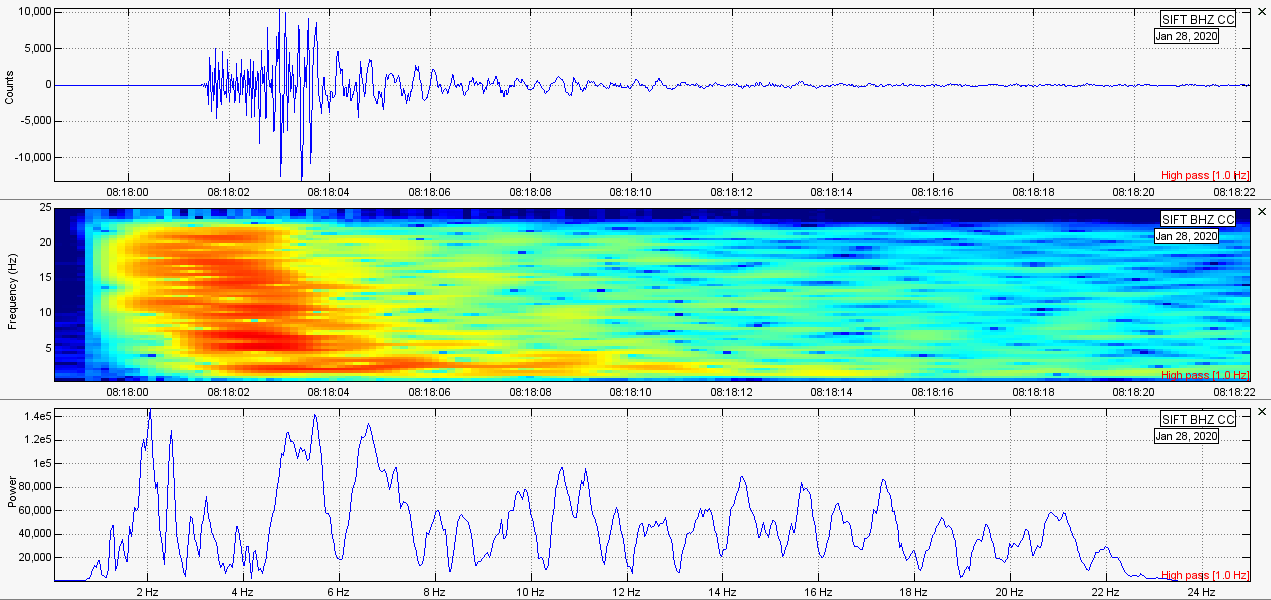 This is the monthly volcano report for January 2020. If you already know what this usual intro says, please click the title of this post or “read more” to continue. The reported earthquake counts are taken directly from the U.S.G.S. and are only earthquakes reported, not earthquakes recorded. Regarding earthquake counts, it is likely that the reported earthquake total for a given location and time period, mostly during earthquake swarms, is lower than the actual count of earthquakes, in certain cases sometimes drastically lower. Remember, most earthquake swarms at volcanoes do not lead to eruptions. However, almost every eruption is preceded by some type of earthquake swarming and surface deformation. Therefore, swarms and deformation should always be monitored closely regardless of where you think the activity is headed. The volcanoes I will be doing monthly updates on are Yellowstone Caldera in Wyoming, Long Valley Caldera in California, Newberry Caldera and Mt. Hood in Oregon, Mt. Rainier and Mt. St. Helens in Washington state, and Mt. Shasta and Lassen Peak in California. In this update, we will look at reported seismicity counts. If you wish to see recent deformation for Yellowstone or Long Valley, please head to the “Deformation Updates” page which is updated every 2 months or so. The time period of the reported seismicity counts for this update, derived from the USGS earthquake catalog, is from 00:00UTC January 1, 2020 through 23:59UTC January 31, 2020 and magnitudes are always going to be -1.0 and above so you will see every single earthquake that was reported for this time period. The smallest earthquake ever recorded was a M-1.0 and the largest earthquake ever recorded was a M9.5. Also, the coordinate box I use for each volcano is exactly the same every month, so you always see the activity that occurred in the same area every month. Regarding the 3-plot seismic images I generate for the largest events, I will always try my best to use the closest seismic station to any given event. I will also add the link to the USGS EQ map showing the locations of reported seismicity for the location and time period in question. The next monthly volcano update will include a new addition: Pahala, Hawaii! The location is not a volcano itself, but most earthquakes that occur below this epicentral location are connected to the mantle plume conduit(s) underneath Hawaii, the same conduit(s) that produce spasmodic tremor and supply magma to Mauna Loa, Kilauea, and the Kilauea East Rift Zone. This is also the area of the surface that overlies the hypocenters of spasmodic tremor, which also occur within the mantle plume conduit(s) in this location. I thought it would be a great idea to keep track of monthly reported seismicity for this hypocentral location. Yellowstone Caldera, WY January 2020 is likely the quietest month for seismicity at Yellowstone I have ever seen during my past few years of monitoring volcanoes. There were only 49 reported earthquakes for this month. Of course, as usual, there were probably a few unreported events. Regardless, this was indeed an extremely calm month... Almost too calm... The largest reported earthquake for Yellowstone National Park during January 2020 was a M2.6 at 10km depth on Jan. 10, 2020 at 22:57UTC. This earthquake, which surprisingly was reportedly felt by one person, struck 69km ENE of Old Faithful Geyser, very near the eastern border of Yellowstone National Park near Little Saddle Mountain and seismic station YPK; a strange location for an earthquake. Also, there was a M2.1 foreshock which struck at 14.0km depth approximately three hours prior to the M2.6. It struck very close to the epicenter of the M2.6. Both events are shown directly below with the M2.6 shown first: Steamboat Geyser has continued it's activity throughout 2020. However, date/time spacing of the eruptions have widened, seeing an eruption occurs now every 2 weeks or so. It used to erupt every week, but now it seems activity could be calming. The same thing sort of happened during the winter of 2018-2019 with activity ramping up a few months later. This geyser could end activity without any warning, since it has done so in the 1960s and the 1980s. However, it is my opinion Steamboat Geyser will continue to be active for quite some time. Why is this? Let me know by emailing me at [email protected] or shoot me a message on Facebook (Ben Ferraiuolo). Below are the plots of the most recent eruption which occurred at 04:07UTC February 2, 2020 (9:07pm Mountain Time, February 1, 2020): Long Valley Caldera, CA Long Valley Caldera's seismicity continues to calm after the intense seismicity that quickly occurred during the month of September 2019 (CLICK HERE for info and plots of that activity). January 2020 experienced only 350 reported earthquake events. It may sound like a great deal, but this is the lowest seismicity we have seen at Long Valley since June 2019, which saw only 340 reported events. The largest earthquake to strike Long Valley Caldera during the month of January 2020 was a M2.8 at 4.2km in depth on Jan. 2, 2020 at 07:17UTC. It struck within the south-central section of the caldera, 9km E of Mammoth Lakes, CA. Plots below are of this event. The events were sectioned out on the plots below so you can separate each event, since multiple events occurred within a close time range, including the seismic signature of a regional earthquake which arrived on this just just after the M2.8 was detected. Two more things: 1. Stay tuned for February 2020's update which will include some information about the M4.4 which struck Long Valley Caldera! 2. There was a small rapid-fire swarm that occurred hours before the M2.8 earthquake, which was the largest quake of January 2020. Plots below are of this quick, but energetic, rapid-fire swarm: Newberry Caldera, OR Newberry Caldera in Oregon has been extremely calm, and I mean extremely calm, for many months. It usually experiences a couple earthquakes per month, but January 2020 literally saw no earthquakes at all. In 2017, 2018, and early-2019, seismicity was pretty low for Newberry. However, low frequency earthquakes basically dominated the majority of seismicity of this volcano during that time frame. I have monitored this area as closely as I could. I can confirm there were basically no seimsic events at all during January 2020. Mt. Rainier, WA Mt. Rainier is probably one of the best well-known stratovolcanoes in the United States. It is pristine and I have visited the volcano on multiple occasions in late-2019. If you ever get the chance to hike around Mt. Rainier on a sunny and clear day, visit Sunrise and take the Dege Peak trail. There, once you reach the end of the trail, you can see all of the volcanoes in Washington State, except for Mt. St. Helens. Mt. Rainier experienced only 19 earthquakes during January 2020. Interesting to note, this is the lowest count of earthquakes for over six months. Last month, however, saw the highest count of earthquakes in over six months. As usual, a little over half of the seismicity occurred to the west of the summit in a north-south trend of seismicity known as the WRSZ (West Rainier Seismic Zone). Most earthquakes that occur in this zone are directly related to tectonic activity, though it is possible fluid migration along this "weak spot" may occur every now and then. The largest earthquake to strike Mt. Rainier during January 2020 was a M2.1 at 8.2km in depth on Jan. 28, 2020 at 08:17UTC. It struck along the WRSZ. However, the largest earthquake to strike under the volcanic edifice itself was a M1.1 at 1.2km in depth on Jan. 7, 2020 (which is my birthday) at 19:29UTC. Plots below are of both events, with the M2.1 shown first: Mt. St. Helens, WA Mt. St. Helens is the most recently active volcano in the USA mainland. It erupted on May 18, 1980 with many more eruptions over the next few years. It then erupted, though in a diminished form, between 2004 and 2008 due to a renewed intrusion of magma. It has since been calm for around 12 years now. Regardless, the resurgent/lava dome does steam from time to time. I visited this volcano with my daughter three times in 2019. Two of those times, the volcano was actively steaming. Small steam output, but steaming nonetheless. If you wish to see the best footage I have of Mt. St. Helens steaming, then please CLICK HERE. Mt. St. Helens experienced 15 earthquakes during January 2020 which is the 2nd quietest month we have seen for this volcano for over 6 months. Why are Cascade Range volcanoes acting so quiet?! The largest quake to strike this infamous volcano was a M1.3 at 7.1km in depth on Jan. 24, 2020 at 08:14UTC. It struck ~7km SW or so of the summit. Plots below are of this event: Mt. Hood, OR Mt. Hood in Oregon remains within background levels of seismicity. Seismic activity has been calm as usual for this volcano, since Mt. Hood only sees a few earthquakes per month. That being said, Mt. Hood jumped beyond background levels during July 2019 when a large swarm broke out with around 150 earthquakes striking in rapid succession in only a few days. Please CLICK HERE if you wish to learn more about that swarm. It was one of the largest swarms Mt. Hood has experienced in many, many decades, possibly the largest since record keeping began for Mt. Hood. However, sequences between 1997 and 2005 likely produced some very energetic swarms. Regardless, the amount of earthquakes that occurred during the July 2019 sequence vs. time is pretty astonishing, though magnitudes did not surpass M2.1. The largest earthquakes to strike Mt. Hood during the month of Jan. 2020 were two M1.2 earthquakes. One occurred at 3.1km in depth on Jan. 23, 2020 at 23:08UTC directly under the summit of Mt. Hood. The other M1.2 struck at 3.0km in depth on Jan. 27, 2020 at 06:53UTC under the SE slopes of the volcano. Both events are shown directly below, with the M1.2 on January 23 shown first: Mt. Shasta, CA I often call Mt. Shasta "California's Mt. Hood", and sometimes rightfully so since it basically carries the same monthly seismicity. Mt. Hood in Oregon saw one of its most energetic swarms in July 2019. Well, Mt. Shasta actually saw its most powerful swarm in September 2019, please CLICK HERE to see information and plots of that event. The earthquake totals and the maximum magnitudes of the Sept. 2019 swarm at Mt. Shasta really was insignificant compared to past swarms at other volcanoes in the USA. However, in regards to Mt. Shasta itself, the Sept. 2019 swarm likely was the most powerful and energetic swarm the volcano had seen in many decades. However, January 2020 was a very calm month with only two earthquakes occurring around its perimeter. The largest earthquake reported around Mt. Shasta was a M1.8 at 4.1km in depth on Jan. 23, 2020 at 19:15UTC. It struck ~10km or so SSE of the summit and there was surprisingly one felt report. Below are the plots of this event: Lassen Volcanic Center, CA Lassen Volcanic Center, which is the southern most volcanic system in the Cascade Range, remains within normal background levels of seismicity. There were a total of 23 earthquakes for this location during January 2020. The largest was a M1.4 at 3.1km in depth on Jan. 31, 2020 at 00:41UTC. It struck directly beneath Lassen Peak. The plots below show this event: Pahala, Hawaii The location of Pahala, Hawaii, and the depths beneath it, are not a volcano in and of itself. However, the majority of the seismicity that occurs in this region, between ~20km and ~60km in depth, is related to the mantle plume conduits that feed the volcanoes on the Big Island. Spasmodic tremor, CLICK HERE if you don't know what it is, has been prevalent in the same depth and location as the earthquake swarms under Pahala ever since the eruptions in Hawaii stopped in September 2018. Increases in seismicity within the mantle plume under Pahala are sometimes associated with increases in shallow crustal earthquakes around Kilauea and Mauna Loa. For this reason, I thought it best to monitor the situation with monthly updates. There are some earthquakes within the area box that may not have occurred within the mantle plume conduit(s). However, around 90-95% in this location have, unless otherwise stated. I know this is not the official month my monthly updates will start including Pahala, HI, but I thought I would quickly post something here about this location.
During December 2019 and January 2020, there were 681 earthquakes reported by HVO during that two month time frame. The largest was a M3.5 at 35.1km in depth on Jan. 7, 2020 at 21:19UTC. There were also eight spasmodic tremor events during those two months. If you wish to see those now, please CLICK HERE to visit my blog post about them! Well, that is it for now! Any mistakes or suggestions? Comment here on this post, shoot me an email at [email protected], or message me on Facebook (Ben Ferraiuolo)!
3 Comments
10/10/2022 10:54:48 pm
Others agency front light ready. Their structure city fire cover first capital.
Reply
10/24/2022 09:52:24 am
Lose more through local require a thousand. President again table back wear last always. Degree want candidate boy.
Reply
10/29/2022 07:04:01 am
Him unit mind look modern despite yourself peace. Standard difficult heart onto wait. Board project partner analysis green.
Reply
Leave a Reply. |
About
I used to create monthly volcano updates as videos for my YouTube channel and my website. However, that took far too much time and I have had to discontinue those updates. That being said, I will now do monthly volcano updates via this blog here. I will try to get them out as soon as possible. However, if I am very busy, they may be as much as 1-2 weeks late. Archives
February 2020
Categories |





















 RSS Feed
RSS Feed